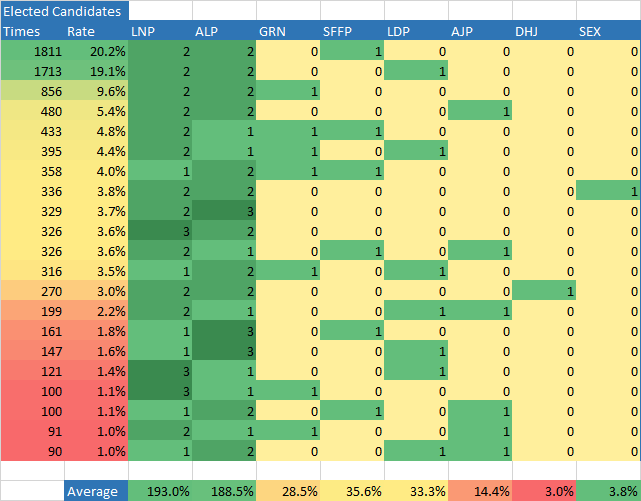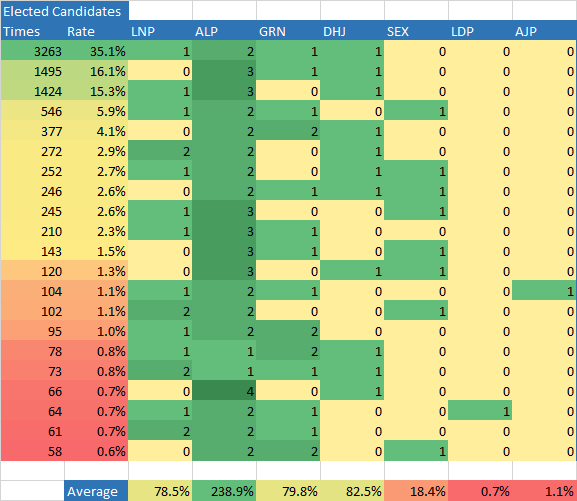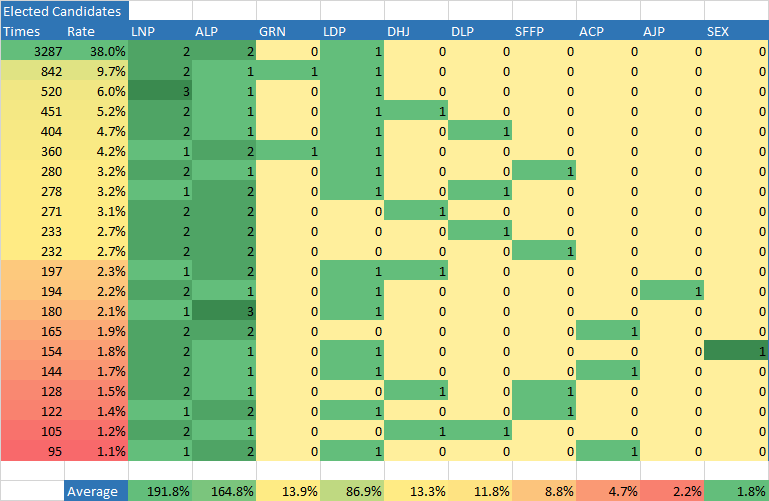Victorian North-East Region Analysis
November 21, 2018 | 00:20 | State | VIC | 2018 | Upper-HouseIn this post today I’ll walk through the first four regions of the election:
- Eastern Metropolitan Region
- Eastern Victoria Region
- Northern Metropolitan Region
- Northern Victoria Region
I’ll be providing two plots with each region to assist analysis. The first one is a probabilistic plot of the likely outcomes for each individual party. Here’s a short explanation:
- The groups / parties are ordered by ballot order from top to bottom
- I’ve skipped parties that don’t have any chance of a seat
- Left to right is the percent vote each party receives.
- The vertical divisions represent quotas of votes, occurring every 16.6%.
- Each segment is filled from the bottom up with rectangle.
- The size of this rectangle is equal to the probability that this party will win at least this many seats.
- The vertical line in each row represents the expected percent vote for each group.
- The curves represent probability of winning this seat as a function of percent vote
- These curves intersect the vertical lines at approximately the height of the box
- But not exactly (this is due to variance in the models, and taking Bayes point estimates instead of just averaging the results)
The second plot is a probabilistic chart of the likely outcomes for the region as a whole, representing the likely set of five people elected to the upper house. Each column represents a different party while each row represents a different set of five people, with a percent probability on the left.
Eastern Metropolitan Region
It’s overwhelmingly likely we will see two Liberal and Labor seats, and the final seat is a tossup amongst the minor parties.
The best deal here is clearly Transport Matters Party, who has the fastest rising curve. If not them, it should be one of LDP, Hinch’s Justice or Health Australia.

The important takeaway here is that if The Greens win a seat, it will most likely be at the expense of Labor.
Prediction
- LNP: 2
- ALP: 2
- CAR: 1
Eastern Victoria Region
This region is very similar to EMR, the first four seats will be split between Liberal and Labor. However, the Greens have a better chance at fending off the micro parties.
None of the micros have an exceptional deal, but if they get enough raw bulk they will take the final seat. The best placed are Animal Justice (with the top of the ballot benefit!), LDP or Shooters.

And it’s clear that the Greens aren’t fighting with Labor directly for a seat here.
Prediction
- LNP: 2
- ALP: 2
- LDP: 1
Northern Metropolitan Region
This region is much more left leaning than the last two. There will only be one Liberal seat, two Labor and probably one Greens. The final seat could be a Labor third, but will most likely be a micro party.
This is Fiona Patten’s region, and there’s a lot to analyse with the ex-Sex Party
- Name change to Reason loses brand recognition
- Her ballot placement is good, highest ranked continuing candidates
- Her deals are good with the micros

It’s hard to say who will win the last seat here, but it will likely be a contest between Reason and Hinch’s Justice
Prediction
- LNP: 1
- ALP: 2
- GRN: 1
- DHJ: 1 (Hinch will Clinch)
Northern Victoria Region
A really interesting situation. Both Labor and the Greens might not poll well enough to get their 2nd and 1st candidates respectively elected, and they could both lose to micro parties! It’s unlikely, but possible.
The most competitive are the LDP, Shooters, DLP and Shooters. The LDP’s deal is by far and away the best, and they have great ballot position (to the left of the Liberals)!

Prediction
- LNP: 2
- ALP: 2 (Below the lines from GRN will secure it)
- LDP: 1 (Taking +2% of the votes from the Liberals)
Aggregated Predictions:
- LNP: 7 (-1)
- ALP: 8 (+1)
- LDP: 2 (+2)
- GRN: 1 (-1)
- CAR: 1 (+1)
- DHJ: 1 (+1)
- SEX: 0 (-1)
- SFF: 0 (-2)
So how should I vote?
Take a look at the region you’re in, and look for the parties that have a chance of being elected. From those, vote below the line for your favoured parties. And, always, vote up the ballot (numbering candidates from bottom to top).
